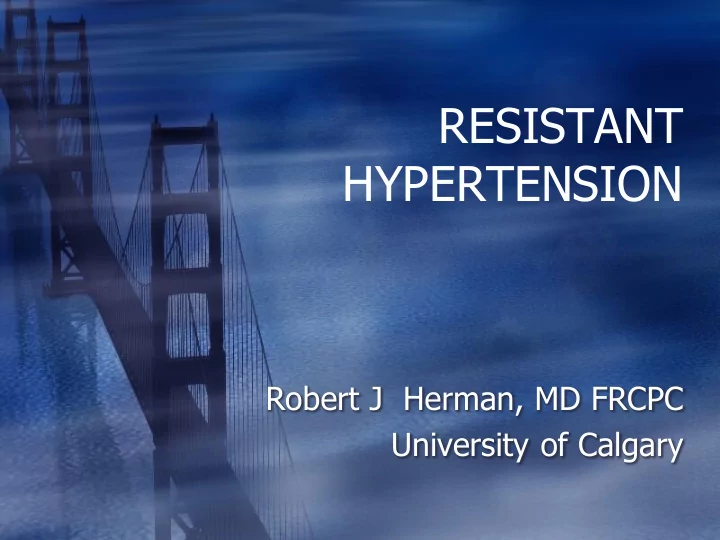

RESISTANT HYPERTENSION Robert J Herman, MD FRCPC University of Calgary
Learning Objectives Know the definition of resistant hypertension Have an approach to the work up and effective treatment of a patient with resistant hypertension Understand the benefits and limitations to new alternatives such as renal denervation No disclosures
Definition: Blood pressure that remains above goal in spite of the concurrent use of 3 antihypertensive agents of different classes. Ideally, 1 should be a diuretic and all agents should be prescribed at optimal doses. AHA Scientific Statement. Hypertension 2008;51:1403-1419
Resistant Hypertension Inadequate medication 45-60% Improper use of diuretics Secondary hypertension 5-20% Chronic Kidney Disease Renal artery stenosis Hyperaldosteronism Thyroid disease Hyperadrenalism Pheochromocytoma Non-compliance/non-adherence 16-60% Whitecoat Hypertension 20-35% Sleep apnea 83% Various sources, including Larochelle CHC 2011
Resistant Hypertension Pseudo-Resistant HTN True Resistant HTN Error in BP Measurement Improper cuff size Improper measurement technique Whitecoat Hypertension Non Adherence / Non Compliance Patient factors Physician factors
Resistant Hypertension Pseudo-Resistant HTN True Resistant HTN Error in BP Measurement Improper cuff size Improper measurement Secondary HTN Other Whitecoat Hypertension OSA Non Adherence/Non Compliance Drugs that cause BP Patient factors Physician factors Renal vascular or parenchymal disease Primary Aldo Other endocrine HTN
Primary Aldosteronism Primary Aldo is common in RHTN (20%) Obesity and metabolic syndrome are very common in IHA, but not APA -Secretory products from human adipocytes strongly stimulate aldosterone release in human adrenocortical NCI-H295R cells. -3 hydroxysteroid dehydrogenase type 6 is over-expressed in zona glomerulosa cells of adrenals from Cry1/Cry2 knockout mice. -GPR30 -MR antagonists are effective Rx of HTN in patients with the metabolic syndrome and substantially reduce the severity of OSA
Nishizaka MK, et al. Am J Hypertens 2003; 16:925-30.
Metabolic Syndrome PA Sympathetic Activation Salt Overload
DM Metabolic Syndrome PA Sympathetic Activation OSA Salt Overload CKD
Shibata H and Itoh H. Am J Hypertens 2012; 25:514
Salt country….. Sodium recommended : 2300 mg / day or less Food Sodium Commercial Broth 900 mg/cup Canned Soup 550-1000 mg/cup Canned Tomato Sauce 1000 mg/cup Frozen Meals Up to 1500 mg/portion Delicatessen 500-1000 mg/2-3 cuts Pasta with seasoning 500-1000 mg/cup C Blais IRCM
Optimize The Diuretic Treatment with Chlorthalidone Chlorthalidone PK properties: longer t1/2, 3-fold greater potency/duration of action Clinical trials: HDFP, ALLHAT, SHEP with chlorthalidone; multiple trials with HCTZ in a combination product Comparison chlorthalidone vs HCTZ: greater 24 hour BP lowering effect at night Ernst ME et al. Hypertension 2006;47:352-8
Chapman N et al. Hypertension 2007; 49: 839-845 2010 Cochrane Review: - five crossover RCTs - mean BP decreases of 20/7 mmHg - no DRAE at Spironolactone doses below 100 mg/day - no data on clinical outcomes
RHTN Rx: Lower on the List but Worthy of Consideration Increase dose of the CEB Clonidine Low dose, 0.1 mg bid Beta-blockers These are renin blockers Labetalol has added 1 -blockade Alpha blockade Doxazosin: Caveat - withdrawn from ALLHAT Adapted from Resistant Hypertension, presented by Zarnky Rocky Mountain/ACP Internal Medicine Meeting 2011
Renal Denervation
Symplicity HTN-1 (n=50) Symplicity HTN-2 (n=106) Symplicity Registry (n=153) Generally well tolerated No RAS, no change in renal function Severe hypotension (3), bradycardia (15), dissections, pseudo-aneurisms Greatly exaggerate BP lowering response Most people have no reduction in meds No hard outcome data Concern over irreversible block of an important regulated pathway
Steps in the Investigation and Treatment of RHTN 1. Confirm the BP measurement 2. Evaluate non-adherence 3. Identify interfering medications, other agents 4. Screen for secondary causes (esp OSA, PHA) 5. Identify abnormal lifestyle issues 6. Optimize antihypertensive therapy Add or switch to chlorthalidone 25 mg/d Add an aldosterone antagonist (12.5-50 mg/d spironolactone) 7. Follow, follow and follow up, again …
Recommend
More recommend